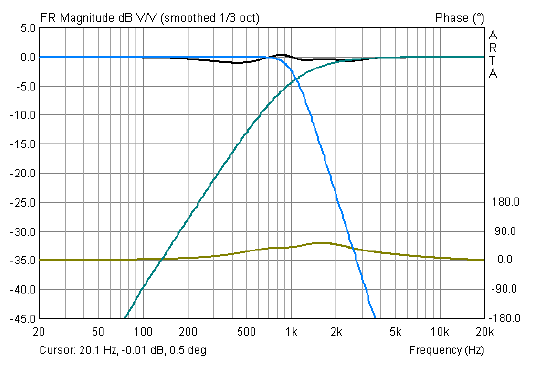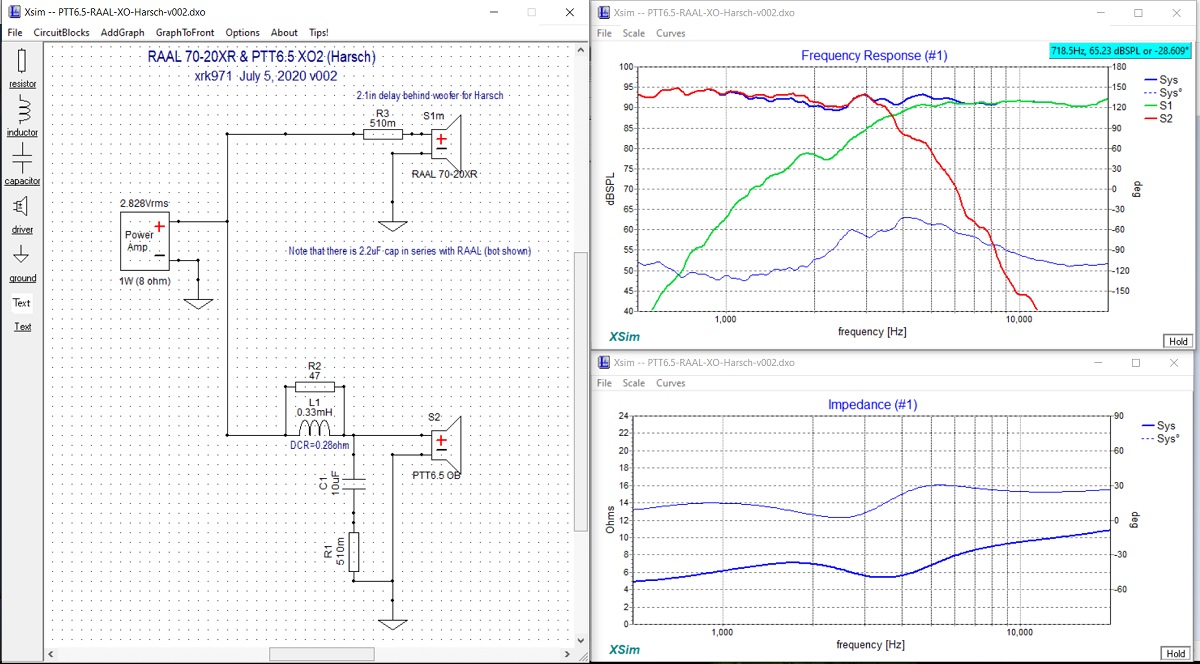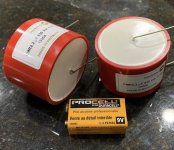Anyone looking for a speaker builders kit of capacitors and resistors should check this out Speaker Builders Resistor/Capacitor Kit (50 Components)- 35% OFF SALE! – Rhythm Audio Design
Something off topic or not, I just read:
by Texbychoice
I bet I can make your speakers sound better.
[ Thought my system was pretty good, although vintage. Time on my hands so decided to try DIY improvements not expecting much. Started by replacing all the electrolytic caps in my speaker crossovers with Dayton Audio caps. Noticeable positive step. Discovered the Humble Capacitor Shootout and read it several times. A CDE 940C series 0.01 uF cap received high marks for bypass duty. Added to the crossover tweeter circuit. Woke up the high end.
Since replacing electrolytic caps yielded positive results, moved to sub woofer amp and main amp. Nichicon audio caps installed. Sub woofer amp first yielded low end could feel in your gut without cranking up the volume. Main amp next. Smoother, bigger sound stage, and vocals cleaner.
Back to the speakers for air core inductors, Kiwame resistors, and CDE 940C caps paralleled to achieve specific values. Used X-Sim crossover design software to adjust values of the original crossover design to get the smoothest calculated response. After going slightly backwards with overuse of bypass capacitors, settled on original circuit with adjusted values. Small bypass remained in the tweeter circuit.
Did the full mod on one speaker for comparison purposes. Definite and significant difference. After some serious listening no doubt the other speaker had to be modified. Wow, simply WOW. With both crossovers modified finally listening to music, not speakers. In some speaker reviews by Ron at New Record Day he described hearing layers and depth. Now I understand what he was trying to describe. Eyes closed the music envelops you. ]
by Texbychoice
I bet I can make your speakers sound better.
[ Thought my system was pretty good, although vintage. Time on my hands so decided to try DIY improvements not expecting much. Started by replacing all the electrolytic caps in my speaker crossovers with Dayton Audio caps. Noticeable positive step. Discovered the Humble Capacitor Shootout and read it several times. A CDE 940C series 0.01 uF cap received high marks for bypass duty. Added to the crossover tweeter circuit. Woke up the high end.
Since replacing electrolytic caps yielded positive results, moved to sub woofer amp and main amp. Nichicon audio caps installed. Sub woofer amp first yielded low end could feel in your gut without cranking up the volume. Main amp next. Smoother, bigger sound stage, and vocals cleaner.
Back to the speakers for air core inductors, Kiwame resistors, and CDE 940C caps paralleled to achieve specific values. Used X-Sim crossover design software to adjust values of the original crossover design to get the smoothest calculated response. After going slightly backwards with overuse of bypass capacitors, settled on original circuit with adjusted values. Small bypass remained in the tweeter circuit.
Did the full mod on one speaker for comparison purposes. Definite and significant difference. After some serious listening no doubt the other speaker had to be modified. Wow, simply WOW. With both crossovers modified finally listening to music, not speakers. In some speaker reviews by Ron at New Record Day he described hearing layers and depth. Now I understand what he was trying to describe. Eyes closed the music envelops you. ]
Last edited:
Can you show us either schematic or photo of the before and after crossover? It’s a pretty simple crossover if I remember correctly.
I recently got the 2.2uF CMR Clarity cap. It’s huge, about same size as some 50uF MKP caps.

I need to rebalance the highs and lows since measurements were on an OB and now in sealed box, the levels are all different.
I recently got the 2.2uF CMR Clarity cap. It’s huge, about same size as some 50uF MKP caps.
I need to rebalance the highs and lows since measurements were on an OB and now in sealed box, the levels are all different.
Attachments
SUMM must always be more than insividual drivers!!! So you must keep working on the crossower design!
Miroslav,
Sum is not always greater than individual - depends on phase. Look what happens at XO frequency when an LR2 has drivers of same polarity. You get a deep cancellation notch.
For Harsch XO, there is a slight dip to the left of the XO frequency and this is one of the tell tale signs that the Harsch XO is being implemented correctly.

S. Harsch XO
Here is the present XO (small dip to the left):

Sum is not always greater than individual - depends on phase. Look what happens at XO frequency when an LR2 has drivers of same polarity. You get a deep cancellation notch.
For Harsch XO, there is a slight dip to the left of the XO frequency and this is one of the tell tale signs that the Harsch XO is being implemented correctly.

S. Harsch XO
Here is the present XO (small dip to the left):
Last edited:
Exactly, you have right, phase is messed up. That is why drivers cancel each other. That's just basics
Miroslav,
You should read up on the Harsch XO. The Harsch XO has obligatory 1dB dip on left of XO freq by design, but that is one of the compromises to get a flatter acoustical phase. Look at acoustical phase - flat with 55deg rise and no wraps. Compare that to acoustical phase of LR2 or LR4 crossover.
You should read up on the Harsch XO. The Harsch XO has obligatory 1dB dip on left of XO freq by design, but that is one of the compromises to get a flatter acoustical phase. Look at acoustical phase - flat with 55deg rise and no wraps. Compare that to acoustical phase of LR2 or LR4 crossover.
If somebody mess up phase by design, it does not make it any better. Nice drivers but crossover must be reworked. Of course, you are free to do whatever you want.
Sure. What’s the step response on your crossover with a “non-messed up” phase look like? Is a right triangle or a messed up cacophony of up and down pulses? Outside of the Harsch XO, the only other XO that is flat phase is 1st order transient perfect. I like those too.
One could argue that the step response isn't particularly important. I've certainly never heard any difference between different orders of crossover providing the drivers were capable. If we can perceive differences in the phase response then the amount by which we can is absolutely tiny and, in my point of view, largely irrelevant (with typical crossover slopes).
It's like sure go for a flat phase response if you aren't compromising anything else in the design, but like miroslav states the Harsch approach just creates a pseudo flat phase by creating this mishmash of interference between the two drivers. It's like where a traditional crossover would have the phase start to shift along comes the Harsch approach and has the two drivers working in a degree of antiphase to cancel out the traditional phase shift.
From a technical point of view an improperly designed 2nd or 4th order crossover, with wonky phase integration can show similar properties. Sure the phase isn't flat like with the Harsch, but it shows points of destructive interference at some points and constructive at others (like the Harsch shows). This sounds bad. Bad at least vs the correctly phase aligned system.
I cannot see why this wouldn't sound the same. And what does the response look like if you invert the polarity on one of the drivers?
It's like sure go for a flat phase response if you aren't compromising anything else in the design, but like miroslav states the Harsch approach just creates a pseudo flat phase by creating this mishmash of interference between the two drivers. It's like where a traditional crossover would have the phase start to shift along comes the Harsch approach and has the two drivers working in a degree of antiphase to cancel out the traditional phase shift.
From a technical point of view an improperly designed 2nd or 4th order crossover, with wonky phase integration can show similar properties. Sure the phase isn't flat like with the Harsch, but it shows points of destructive interference at some points and constructive at others (like the Harsch shows). This sounds bad. Bad at least vs the correctly phase aligned system.
I cannot see why this wouldn't sound the same. And what does the response look like if you invert the polarity on one of the drivers?
Some people are more sensitive to transient perfect speakers than others. I can hear the difference in drums, guitar, piano, and stand up bass very clearly. Having both woofer and tweeter of the same polarity is important for this effect and with LR2/4 the tweeter is always inverted. On an LR2, the phase varies 180deg over the audible range, it is always changing and never flat. Maybe some people have grown accustomed to that sound? For me, once I heard a full range driver I knew it was right and then pursued multi ways with a similar flat phase. This included 1st order, the B&O hole-filler XO, and now Harsch. But to each his own. For me it sounds more “right” than LR2/4.
This has so far been a delicate topic with many aspects so I don't want to bound in with any general statements.
5th, with regard to the treble being in phase it kind of doesn't count because of what it had to do to get there. In cases like this I find it better to look at group delay, which is basically the same phase information put differently.
5th, with regard to the treble being in phase it kind of doesn't count because of what it had to do to get there. In cases like this I find it better to look at group delay, which is basically the same phase information put differently.
Attachments
Yes and I cannot hear it. But if the phase response through the crossover point is messed up, with regions of destructive interference and the like, even if the frequency response is reasonably flat, this I can hear as diffuse imaging.
Yes, and an interesting observation.
You may find that what points toward the ceiling reflection point can be different to what points at the listening position. In fairness this could be a consideration with any crossover.
You may find that what points toward the ceiling reflection point can be different to what points at the listening position. In fairness this could be a consideration with any crossover.
But if the phase response through the crossover point is messed up, with regions of destructive interference and the like, even if the frequency response is reasonably flat, this I can hear as diffuse imaging
But if the acoustical phase (as measured by a mic or heard by our ears) is flat through this “messed up” region, how do you hear it?
I agree that an improperly designed crossover that may be flat by has tons of phase shift sounds bad - I call it “phasey” and it is more apparent when I rotate my head at an angle.
I have tried this with DSP by adding lots of phase wrap but keeping response flat. It’s audible and annoying. However, here, the phase shift is a gradual 55deg rise and fall. Not so audible.
Thinking about zero phase at the speaker, but listening at 3m distance. At 20Hz that's about 60 degrees. By 20kHz there are about 174 rotations and 60,000 degrees.
I have two horns which seems to want tweeter polarity inverted on electric LR4.LR4 is not tweeter inverted.
Must be acoustic slope which do it like that.
- Home
- Loudspeakers
- Multi-Way
- RAAL 70-20xr and PTT6.5 Compact TL

